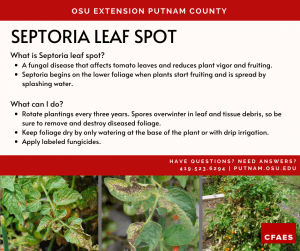The month of August always ushers in a bounty of zucchini, tomatoes, and other produce from home gardens – along with many questions on problems gardeners face. Aside from fruit trees, the Extension office receives the most questions regarding tomato pests and problems. Within the last few weeks, reports of blossom end rot, leaf spots, cracking fruit, and hornworms have come in.
Blossom end rot is a disorder of tomato fruit (and peppers, zucchini, and summer squash) caused by a lack of calcium reaching the fruit as it develops. Blossom end rot tends to develop when plants are under moisture stress with high air temperature and humidity.
Calcium does not move easily or uniformly through plants – and often ends up in the leaves but not the fruit. Under high moisture stress, water containing calcium and other minerals moves rapidly to the leaves but not to the fruit. This results in a lack of calcium needed by the fruit as it rapidly expands. When calcium is not available, a dark, blackened lesion forms on the bottom or “blossom end” of the fruit.
Gardeners can prevent blossom end rot by mulching around the base of their tomato plants and by providing consistent watering during June and July as the tomato fruit develop. Adequate supplies of calcium should also be provided as needed with fertilizer.
Mulching and consistent watering of tomato plants prevent another issue from occurring – fruit cracking. When dry soils are heavily watered or a rain event occurs, the tomato plant will quickly take up water. Too much water moving to the fruit in a short period of time causes it to crack. Keeping soil consistently moist will reduce fruit cracking.
Many tomato plants develop leaf spotting caused by the fungus Septoria. Septoria leaf spot develops on tomato plants when the foliage remains wet – either from frequent rains or overhead watering. Septoria spores survive the winter in plant material or the soil to infect new plants the following year. This is why it is important to water tomatoes at the base of the plant or with drip hoses, remove and destroy infected foliage, and rotate your tomato plantings every three years.
The fungus begins on the lower leaves forming tiny tan spots with a darkened border. These spots can merge to form larger lesions on the leaves. If not treated, Septoria will kill the tomato plant before the fruit have a chance to fully ripen.
Fungicides with the active ingredient chlorothalonil, maneb, mancozeb, or copper fungicides are labeled for control of Septoria on tomato. When applied early and often as directed, plants will
recover and grow through the end of the season. Make sure to read fungicides labels and follow all label directions.
